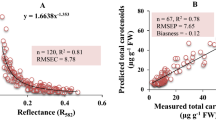Abstract
A method for the determination of the composition of carotenoids of tomato fruits of different colors is proposed using a combination of spectrophotometry and chromatography. An explanation of the elution order of mono-cis-isomers of lycopene under the conditions of reversed-phase chromatography on traditional “monomeric” reversed C18-phases is proposed for the first time. It was found that, for prolycopene, (7Z, 9Z, 7'Z, 9'Z)-lycopene, which is responsible for the orange color of fruits, there is an almost imperceptible transition in normal examination in the vibronic structure of the electronic absorption spectrum with the lowest energy, λmax(1) = 486.2 nm. The main carotenoids of tomato fruits of different colors were determined: trans-lycopene and its cis-isomers for fruits of red and pink colors, protolycopene and other carotenes preceding its biosynthesis for fruits of orange color, and the carotenoid composition of yellow tomatoes significantly differing from that of tomatoes of first two colors by a considerable accumulation of lutein. For the quantitative assessment of the concentration of carotenoids with different chromophores, a calculation system ensuring the determination of the contribution of each of the components of complex mixtures was proposed.





Similar content being viewed by others
REFERENCES
Korneeva, A.V., Ross. Med. Zh. Klin. Oftal’mol., 2019, vol. 19, p. 54.
Tan, B.L. and Norhaizan, M.E., Molecules, 2019, vol. 24, p. 1801.
Olaizola, M., Ch. 13, in Marine Nutraceuticals and Functional Foods, Barrow, C. and Shahidi, F., Eds., Boca Raton: CRC, 2007, p. 332.
Davinelli, S., Nielsen, M.E., and Scapagnini, G., Nutrition, 2018, vol. 10, p. 522.
Story, E.N., Kopec, R.E., Schwartz, S.J., and Harris, G.K., Ann. Rev. Food Sci. Technol., 2010, vol. 1, p. 189.
Clinton, S.K., Nutr. Rev., 1998, vol. 56, no. 2, p. 35.
Belokurova, E.S. and Pankina, I.A., Tekh. Tekhnol. Pishch. Proizvod., 2018, vol. 48, no. 2, p. 162.
Burri, B.J., Chapman, M.H., Neidlinger, T.R., Seo, J.S., and Ishida, B.K., Int. J. Food Sci. Nutr., 2009, vol. 60, no. 1 (suppl.), p. 1.
Unlu, N.Z., Bohn, T., Francis, D., Clinton, S.K., and Scwartz, S.J., J. Agric. Food Chem., 2007, vol. 55, p. 1597.
Zechmeister, L., Lerosen, A.L., Went, F.W., and Pauling, L., Proc. Natl. Acad. Sci. U. S. A., 1941, vol. 27, p. 468.
Clough, J.M. and Pattenden, G., J. Chem. Soc., Perkin Trans. 1, 1983, p. 3011.
Johjima, T., J. Jpn. Soc. Hortic. Sci., 1993, vol. 62, p. 567.
Daood, H.G., Bencze, G., Palotás, G., Pék, Z., Sidikov, A., and Helyes, L., J. Chromatogr. Sci., 2014, vol. 52, p. 985.
Isaacson, T., Ohad, I., Beyer, P., and Hirschberg, J., Plant Physiol., 2004, vol. 136, p. 4246.
Yoo, H.J., Park, W.J., Lee, G.-M., Oh, C.-S., Yeam, I., Won, D.-C., Kim, C.K., and Lee, J.M., Molecules, 2017, vol. 22, p. 764.
Hengartner, U., Bernhard, K., Meyer, K., Englert, G., and Glinz, E., Helv. Chim. Acta, 1992, vol. 75, p. 1848.
Hirota, S., Watanabe, K., Arinobu, T., and Tsuyuki, H., Food Sci. Technol. Int., 1996, vol. 2, p. 150.
Takehara, M., Nishimura, M., Kuwa, T., Inoue, Y., Kitamura, C., Kumagai, T., and Honda, M., J. Agric. Food Chem., 2014, vol. 62, p. 264.
Amorim, A.G.N., Souza, J.M.T., Santos, R.C., Gullón, B., Oliveira, A., Santos, L.F.A., Virgino, A.L.E., Mafud, A.C., Petrilli, H.M., Mascarenhas, Y.P., Delerue-Matos, C., Pintado, M.E., and Leite, J.R.S.A., Eur. J. Lipid Sci. Technol., 2018, vol. 120, no. 3.
Stah, W., Sundquist, A.R., Hanusch, M., Schwarz, W., and Sies, H., Clin. Chem., 1993, vol. 39, p. 810.
Deineka, V.I., Anh Van Nguyen, and Deineka, L.A., Russ. J. Phys. Chem., 2019, vol. 93, no. 12, p. 2490.
Author information
Authors and Affiliations
Corresponding author
Additional information
Translated by V. Kudrinskaya
Rights and permissions
About this article
Cite this article
Deineka, V.I., Burzhinskaya, T.G., Deineka, L.A. et al. Determination of Carotenoids of Tomato Fruits of Different Colors. J Anal Chem 76, 196–203 (2021). https://doi.org/10.1134/S1061934820120060
Received:
Revised:
Accepted:
Published:
Issue Date:
DOI: https://doi.org/10.1134/S1061934820120060




